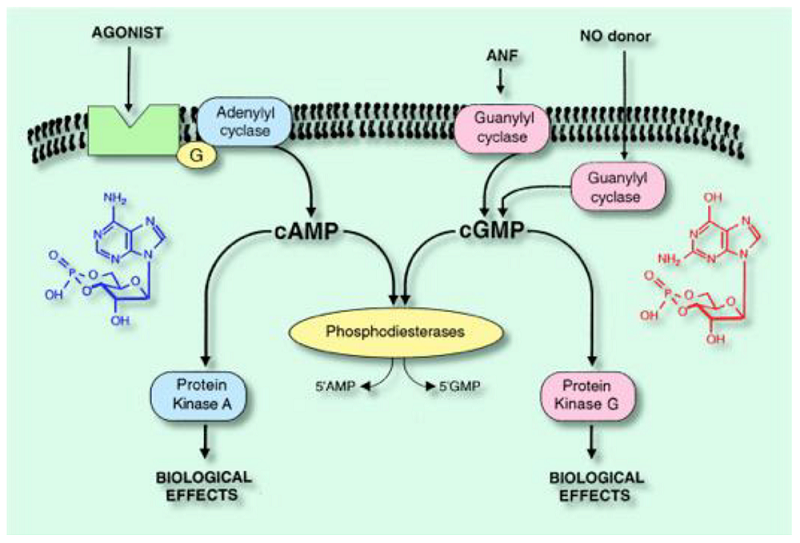Phosphodiesterases (PDEs) are a large family of enzymes that hydrolyze the second messengers cyclic adenosine monophosphate (cAMP) and cyclic guanosine monophosphate (cGMP) into their inactive 5′-monophosphate forms. By controlling intracellular levels of cAMP and cGMP, PDEs shape downstream signaling cascades that regulate cell proliferation, contractility, inflammation, neuronal plasticity, metabolism and many other physiological processes.
PDEs are divided into multiple families (PDE1–PDE11) and numerous isoforms with unique tissue distributions, regulatory mechanisms and substrate preferences. That diversity makes PDEs both attractive and technically challenging drug targets: selective inhibition or activation of individual PDE isoforms can result in therapeutically useful actions while minimizing off-target effects.
 Fig. 1. Intracellular signaling and cyclic nucleotide phosphodiesterases (Lugnier C, 2022).
Fig. 1. Intracellular signaling and cyclic nucleotide phosphodiesterases (Lugnier C, 2022).
Our PDE screening services
Creative Bioarray's PDE screening services leverage high-throughput Fluorescence Polarization (FP) technology to quickly and accurately determine the inhibitory activity of a compound for a given PDE subtype. The core principle of this method is based on the hydrolysis of the substrate (fluorescently labeled cAMP or cGMP) by PDE.
When the substrate is not hydrolyzed, it binds with antibodies to form large molecular complexes, resulting in high fluorescence polarization values. When PDE is added, the substrate is hydrolyzed and the products (AMP or GMP) have very low binding affinity with antibodies. The fluorescent probe thus freely rotates in solution, and the fluorescence polarization value is reduced. When test compounds are added, if they have inhibitory activity on PDE, the hydrolysis of the substrate will be inhibited and the fluorescence polarization value will stay at a higher level.
Main detection targets:
We provide comprehensive PDE subtype screening services, covering the most relevant targets in drug development. Our detection targets include, but are not limited to:
| List of Targets | ||||
| PDE1A | PDE3B | PDE4B2 | PDE5A1 | PDE9A2 |
| PDE1B | PDE4A10 | PDE4C1 | PDE6C | PDE10A1 |
| PDE1C | PDE4A1A | PDE4D2 | PDE7A | PDE10A2 |
| PDE2A1 | PDE4A4B | PDE4D3 | PDE7B | PDE11A |
| PDE3A | PDE4B1 | PDE4D7 | PDE8A | |
Service Features
- High-Throughput and High Efficiency: Utilizing advanced Fluorescence Polarization (FP) technology platforms, we can rapidly screen large-scale compound libraries, significantly shortening the drug discovery cycle.
- Precision and Reliability: Our detection system has undergone rigorous internal validation to ensure the accuracy and reproducibility of data.
- Professional Team: Our technical team is composed of experienced pharmacology and enzymology experts, capable of providing clients with professional experimental design and data analysis support.
- Flexible Customization: The technical team has experience in pharmacology and enzymology, and can offer clients professional support in experimental design and data analysis.
Reference
- Lugnier, C. The Complexity and Multiplicity of the Specific cAMP Phosphodiesterase Family: PDE4, Open New Adapted Therapeutic Approaches. International Journal of Molecular Sciences. 2022. 23, no. 18: 10616.
- Phosphatase Screening Services
- Poly (ADP-ribose) Polymerase (PARP) Screening Services
- GPCR Screening Services
- Kinase Screening Services
- Transporter Screening Services
- Ion Channel Screening Services
- HSP90 Screening Services
- Nuclear Receptor Screening Services
- Protease Screening Services
- Ubiquitin Screening Services
- High Throughput Screening Services
- High Content Screening Services
- Target-based Screening Services
- Phenotypic Screening Services
- Apoptosis Screening
- Epigenetics Screening Services